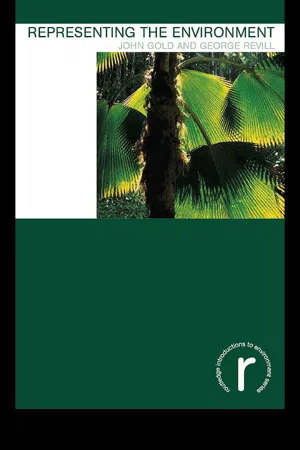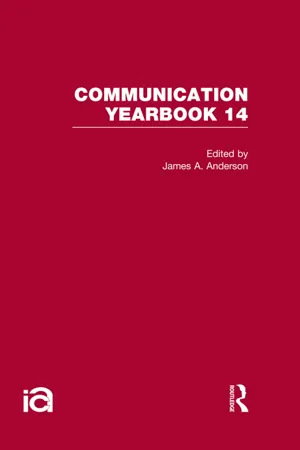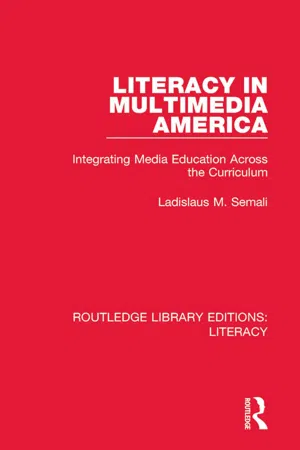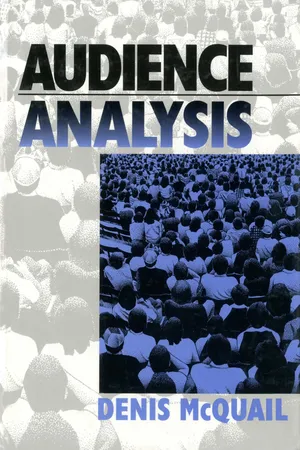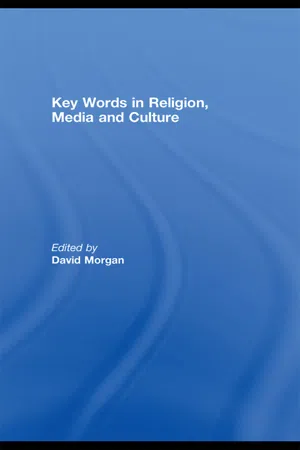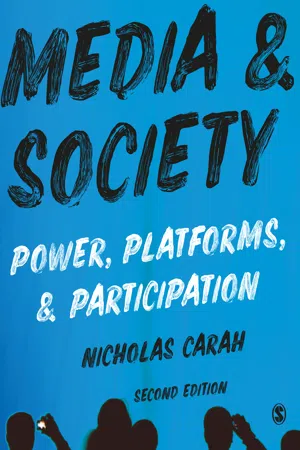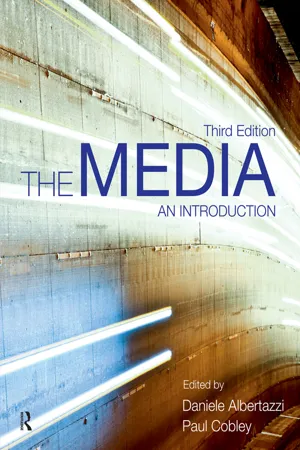Social Sciences
Media Representations and Audiences
Media representations refer to the ways in which the media portrays individuals, groups, and events. Audiences are the consumers of these representations, and their interpretations and reactions to media content are influenced by factors such as culture, identity, and personal experiences. Understanding the relationship between media representations and audiences is crucial for analyzing the impact of media on society.
Written by Perlego with AI-assistance
Related key terms
Related key terms
1 of 4
Related key terms
1 of 3
8 Key excerpts on "Media Representations and Audiences"
- eBook - ePub
- John R. Gold, George Revill(Authors)
- 2004(Publication Date)
- Routledge(Publisher)
3 Representations in context
This chapter:- examines strategies for studying the audience’s consumption of environmental representations;
- considers the contexts in which representations are produced;
- explores the concepts of cultural politics, ideology and discourse;
- provides a range of basic approaches for the study of the discursive role of representations in society.
Audiences and the media
The media occupy a central place in any study of environmental representations. Traditionally, ‘media’ meant the ‘media of mass communication’, by which technologically based systems transmitted content (or messages) through print, broadcasting, posters or film to remote and scattered audiences. More recently, though, the idea of what constitutes ‘media’ has expanded dramatically. If media transmit content in symbolic form to an audience, then architecture, clothes, recorded music, food packaging, jewellery and skin tattoos are legitimately media. Moreover, many new media no longer conform to the established model. The convergence of television, computers, wireless technology, digital networks and mobile telephones brings patterns of use that bear little resemblance to the ‘fireside’ consumption of early radio and television programmes.The word ‘consumption’ needs clarification. We stressed the importance of the audience’s active participation in shaping the meaning of environmental representations at the end of Chapter 2 . In this context, it might seem that media research has much to offer, given that audience studies have preoccupied media researchers since the 1920s (McQuail, 1997). Sadly, however, the findings of that research have proven continually disappointing. Researchers have often attempted to trace direct and measurable audience response to communication, usually finishing by either showing no discernible effects or recognising that any effects are very difficult to assess and quantify. The problem lies partly with conceptual understanding and partly with methodology. In terms of the former, researchers reluctantly accept that the media do not function in isolation and that, in most circumstances, any impact that they might have is itself mediated - eBook - ePub
- James A. Anderson(Author)
- 2012(Publication Date)
- Routledge(Publisher)
reception, mass communication studies of the 1980s began to reexamine some fundamental issues con- cerning the nature and origins of meaning in human communication. Whereas audiences have been the object of continuous and substantial study since the beginnings of the field, current work implies a reconceptualization of mass communication processes as everyday practices producing and circulating meaning in society, particularly emphasizing the constitutive role of audiences as interpretive agents. The attention given to the decoding and social uses of media content has been apparent both in empirical research on audience responses and in cultural studies about media discourses. Further, it has entailed a dialogue across the critical-empirical, qualitative-quantitative boundaries of the field (Jensen, 1987; Jensen & Rosengren, in press; Schröder, 1987). The turn toward reception is, perhaps, most distinctively articulated in the recent tradition of qualitative empirical audience studies (Ang, 1985; Jensen, 1986; Katz & Liebes, 1984; Lindlof, 1987; Lull, 1988b; Morley, 1980, 1986; Radway, 1984), which have accumulated evidence that mass media audiences make their own sense of media content in complex and unexpected ways. Audiences may, to a significant degree, modify or oppose the specific meanings that appear to be proffered by mass media, and may, furthermore, appropriate those meanings for alternative ends as they engage in a questioning and reconstruction of social reality.Behind this reconceptualization lies the as yet undeveloped assumption that meaning is simultaneously a social and a discursive phenomenon. On the one hand, meaning may be defined as the outcome of an interest-driven, situated act of interpretation performed by a social agent. This definition locates meaning in the real world of people, power, and pleasures. On the other hand, meaning traditionally is associated with particular vehicles – texts or other discursive forms. Discourse theory may be said to suggest that subjects and social realities are primarily functions of the operations of discourse, so that, for analytical purposes, media audiences should also be conceptualized as discourses or, perhaps, discursive strategies of interpretation. It is this duality of the concept of meaning that may, in part, account for the major ambiguities and conflicts over how to approach communication, both theoretically and methodologically, that have emerged in some recent attempts to take stock of reception analysis (for instance, see Critical Studies in Mass Communication, vol. 5, no. 3, 1988; and Cultural Studies, vol. 2, no. 3, 1988). (The reader may also wish to see Jensen, 1986, Chapter 10 - eBook - ePub
Literacy in Multimedia America
Integrating Media Education Across the Curriculum
- Ladislaus M Semali(Author)
- 2017(Publication Date)
- Routledge(Publisher)
To get at the values, interests, and desires in media representations, one has to examine the use of language, or signs and images that stand for or represent things. I suppose to do this is complex simply because the meaning so produced or constructed by representation is not a universal truth or neutral fact and cannot be read in a straightforward manner. As explained in previous chapters, meaning is entangled in social, cultural, economic, and political settings, which preside over the context through which both the reader/viewer and the communicator engage in an exchange and interpretation of messages. Hall (1997) reminds us that when we decide to examine the representation of an event or people, we are in fact entering into the very constitution of things; this is a constitutive process, as important as the economic or material “base” in shaping social subjects and historical events—not merely “a reflection of the world after the event” (p. 5).For Hall, therefore, media representation is a way of giving things meaning by how we represent them—the words we use about them, the images of them we produce, the emotions we associate with them, the ways we classify and conceptualize them, the values we place on them (p. 3). In other words, media representation refers to the way images and language actively construct meanings according to sets of conventions shared by and familiar to makers (producers) and audiences (viewers). In this sense, it is a continuous struggle over meaning.CRITICAL LITERACY AND MEDIA LITERACY CURRICULUMCritical literacy is a contested educational ideal. Even though “critical” pedagogy has been en vogue for the past fifteen years, scholars continue to question what it means to be critical and how such a concept can be implemented across the curriculum. As I explained in Chapter 3 - eBook - ePub
- Denis McQuail, Mark Deuze(Authors)
- 2020(Publication Date)
- SAGE Publications Ltd(Publisher)
Audience as ‘the people addressed’. Referring to the group of people imagined by the communicator and for whom content is shaped. This is otherwise known as the ‘inscribed’ or ‘interpellated’ audience.- Audience as ‘happening’. The experience of reception alone or with others as an interactive event in daily life, contextualized by place and other features.
- Audience as ‘hearing’ or ‘audition’. Essentially refers to the participatory audience experience, when the audience is embedded in a show or is enabled to participate by remote means or to provide a response at the same time.
There are other possibilities for defining a distinctive kind of audience, depending on the medium concerned, the activity under investigation, and the perspective adopted. Online and mobile media provide for a variety of communicative relations that do not always neatly fit the typologies created for mass communication. Among the key challenges of contemporary audience theories and definitions are the ubiquity of media (leading to a ‘high choice’ media environment), the multi-sited and global spread of media options, and audiences becoming increasingly media-literate, critical and reflexive. Audiences are increasingly drawn into the production process of media industries too, which further complicates their existence as more or less ‘passive’ readers, viewers, listener or users. Correspondingly, as Napoli (2011, 2012) notes, relatively straightforward measuring and valuing audiences merely on the basis of their exposure to media content is making way for more complex ways of measuring and valuing audiences on the basis of their ‘engagement’ with the content.A fundamental debate regarding the notion of ‘audience’ concerns on the one hand its existence as (a group, network or community of) individuals using, responding and giving meaning to mediated messages, and on the other hand the engagement of people interacting with an open text (incorporating any kind of medium or channel). The first perspective warrants research into media effects, while the second emphasizes various processes of interpretation, struggle and resistance. - eBook - ePub
- Denis McQuail(Author)
- 1997(Publication Date)
- SAGE Publications, Inc(Publisher)
The question of media effects lies outside the scope of this book, but it is important to draw attention, however briefly, to the wide implications of reception theory for the study of effects. New audience theory proposes that not only the significance of the media experience as such but also the meaning derived from media content is very dependent on the perceptions, experiences, and social location of audience members (Jensen, 1991). Audiences “decode” the meanings proposed by sources according to their own perspectives and wishes, although often within some shared framework of experience (Hall, 1980).This certainly applies to the complex and ambiguous messages of fiction (e.g., the lessons drawn by women readers of pulp romance fiction—Radway, 1984). It is also true of the normative judgments about aesthetic or moral quality of media content, as discussed below. We cannot assume that even basic “factual” information will be understood as sent. The evidence for the seemingly poor or faulty understanding of news is overwhelming (e.g., Gunter, 1987; Robinson & Levy, 1986), although this is sometimes mistakenly attributed to deficiencies on the side of sender.Reception analysis of news (e.g., Graber, 1984; Jensen, 1988) makes it clear that frameworks for understanding news depend very much on the social position and outlook of the receiver, who is both able and strongly inclined to fit the “facts” as reported into local and personal frames of interpretation and relevance. The audience for news is always busy constructing and developing cognitive and evaluative versions of “real” events in line with its own perspective on the world.Media Use as Social Pathology
The various media have acquired a complex set of definitions that connect them to other aspects of personal social experience. On the one hand, they are an almost inevitable accompaniment to everyday life, requiring us to adapt our social habits (such as eating and conversation) to the fact of their existence. On the other hand, they are a valuable and varied resource for helping us to handle social situations and personal difficulties (Pearlin, 1959). With respect to the latter, we can think of media as a means of establishing a certain mood, of cheering us up, taking us out of ourselves, stimulating various feelings, helping us to remember and reflect as well forget. There is certainly evidence of media being consciously used for such purposes (Zillman & Bryant, 1985). - eBook - ePub
- David Morgan, David Morgan(Authors)
- 2008(Publication Date)
- Routledge(Publisher)
2 AudiencesStewart M. Hoover
Media change and religious change Religious authority and media authority The religious “marketplace” “Religious” and “secular” media The culturalist turn in media studies Audiences in context Religion, spirituality, and the “common culture”
Audiences are essential to the media. The entire notion of mass communication depends on the existence, or cultivation, of a large number of people interested in attending to a given medium. There is, further, a relationship between generally accepted conceptions of the various media and the audiences that are attracted to them. For example, newspapers such as the New York Times or the Washington Post enjoy the devoted readership of the intelligentsia and managerial elites, whereas Web logs (or “blogs”) command far greater attention among youth. Thus, media influence varies according to audience.Our received ideas about mass communication, and thus media audiences, are the products of particular times and particular media structures. The term mass communication best describes a few particular media and particular conditions of audience practice. It applies to broadcast television over large networks particularly well but also fits large-circulation newspapers, film, and the popular music industry. “Mass communication” does not work so well with other aggregations of media audiences that nonetheless share commonalities with these examples, such as music performance venues, specialized videos or DVDs, limited-circulation newspapers and magazines, and print literature.A process of rethinking mass communication and media audiences has been underway for at least three decades. This rethinking has coincided with—and to some extent has also been encouraged by—the reconceptualizing of a particular mode of audience practice: the consumption of mediated communication in relation to religion and spirituality. Seeing audiences anew has involved a shift in the way in which media scholars and critics characterize those audiences. Instead of regarding “religious audiences,” whose identities and motivations toward religious or spiritual material would be assumed to reside in an essential, definitive religiosity, it has become important to think of the audience for religion - eBook - ePub
Media and Society
Power, Platforms, and Participation
- Nicholas Carah(Author)
- 2021(Publication Date)
- SAGE Publications Ltd(Publisher)
As media organizations grew and became more institutionalized and commercialized, they developed methods to quantify, describe and position their audiences for advertisers. Audience and market research techniques and industries developed in collaboration with media organizations. Ratings provided ways of creating the audience as a reliable and quantifiable product that could be sold to advertisers. The size, location and demographic characteristics of the audience are quantified for advertisers who need to know how many of certain types of people’s attention they are buying when they purchase advertising time and space. Qualitative and cultural information about audiences is also important (Hackley 2002; Holt 2002). Media organizations and advertisers seek to qualify the lifestyles, cultural interests, values and practices of their audiences. This informs the production of both media content and advertising. Producers develop ways of understanding how audiences consume media content as part of their everyday lives. They want to understand how media, such as television, are incorporated into the rhythms of everyday life. The development of breakfast television, for instance, responds to the morning routines of middle-class families. Breakfast programmes are light, conversational and repetitive. They are attuned to an audience that has the television on in the background as they get ready for work and school. While the primary driver in the creation of audiences is often their commercial value, these processes are also entwined with broader political and social processes. Advertising is a central part of the broader representational and social role of the media. Just like news, films, books and television programmes, advertising plays a role in creating public identities and social formations (Turow 1997: 26). The work of producing audiences as valuable social formations overlaps with the work of creating publics that sustain particular political formations and configurations of power (Livingstone 2005, 2019).Media organizations invested in the development of these technologies throughout the twentieth century. Television, for instance, relied on a combination of in-home meters, diaries and surveys (Balnaves et al. 2011: 100). Each technology has limitations. Meters monitor what programme is watched whenever the television is on. These provide an accurate count of what is being watched, but they do not enable researchers to specify who in the family is watching. Some research firms added push-button meters that required the members of a family watching to press the button when they were watching. This provided some measure of who was watching. But people wouldn’t push the button if they didn’t want to disclose what they were watching. Diaries provide more detail on who watches what, but they are hampered by getting participants to accurately complete them. People routinely underestimate how much time they spend consuming media. Surveys are hampered both by people’s recall of what they watched, and their willingness to admit to watching certain kinds of content (Balnaves et al. 2011). - eBook - ePub
The Media
An Introduction
- Daniele Albertazzi, Paul Cobley(Authors)
- 2013(Publication Date)
- Routledge(Publisher)
et al. 2003), to the impact of a scandal about the safety of a vaccination (Boyce 2007), from the way in which celebrity culture influences public debate (Couldry and Markham 2007) to the influence of reading blogs (e.g. Sweetser and Kaid 2008). The rich seam of work help to connect media studies to key issues of the day, including debates about contemporary events, theories about citizenship, emerging media trends and the implications of new technologies.Understanding different ways of assessing audiences is crucial to a sophisticated approach to researching the media’s role in contemporary society. Audience research can take many forms, but we ignore questions about influence at our peril. However, sometimes an alternative focus may be more appropriate – it is a question of context, and of assessing the costs and benefits of different foci. Although my own research, for example, has often focused on effects/influence, in recent work I was particularly concerned about the myths that were being promulgated about a simplistic media ‘effect’ in the area under study. My colleagues and I were examining the representation of stem cell research and human cloning (Haran et al. 2008). We found that policy makers often blamed the media in general, and science fiction in particular, for public concerns about such emerging biotechnologies. However, our focus group data suggested that although such media could resource public imaginings, people’s concerns were often informed by a much wider repertoire of understanding. Questions about implications and use/abuse of biotechnologies were linked to understanding of the social and political contexts of science and their trust in government (a trust which had been shaken by scandals around health or foreign policy). In writing up this research, we therefore focused on questioning the simplistic model of ‘media effects’ and sought to replace it with a more nuanced understanding of why people might wish to challenge some ‘advances’ being promoted by scientists and policy makers (Haran et al
Index pages curate the most relevant extracts from our library of academic textbooks. They’ve been created using an in-house natural language model (NLM), each adding context and meaning to key research topics.
Explore more topic indexes
Explore more topic indexes
1 of 6
Explore more topic indexes
1 of 4
